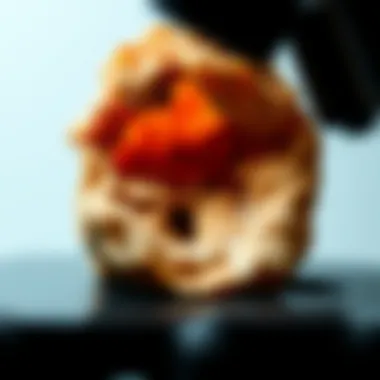Microscopic Exploration of Rocks: Techniques and Insights


Intro
The world of rocks is a vast and intricate tapestry, one that features textures and components invisible to the naked eye. For rock enthusiasts and collectors, stepping into this microscopic universe holds profound implications, not just for identification and classification but for understanding geological history. Through the lens of microscopy, we can reveal hidden narratives and secrets locked within these natural artifacts, transforming the way we perceive and appreciate them. This guide will navigate through the essential techniques and tools necessary for effective microscopic study, while also highlighting the geological significance of various features observed under a microscope.
As we embark on this journey, it’s important to grasp that our focus transcends mere surface-level beauty of rocks. It dives deep into their essence, showcasing how tiny structures relate back to larger geological processes. The possibilities extend beyond mere collections; they spark curiosity and lead to insights about Earth’s history itself. By equipping ourselves with knowledge of microscopy's methodologies and applications, we open doors to a richer, more informed rock collecting experience.
Let’s peel back the layers and dive into the history and origins of rock collecting and microscopy, providing context for our exploration of this fascinating field.
Prolusion to Microscopy in Geology
Microscopy provides a gateway into an unseen universe, unlocking the intricate details within rocks that are often overlooked by the naked eye. This branch of geology is not merely a tool but a vital aspect of understanding the complex processes that shape our Earth. By utilizing advanced imaging techniques, geologists and rock enthusiasts can explore mineral composition, structure, and texture at a microscopic scale, revealing clues about the formation history and environmental conditions associated with various rocks.
The Role of Microscopes in Rock Studies
Microscopes have transformed rock studies in profound ways. For one, they enable geologists to identify minerals based on their optical properties, which can be critical for classifying rock types. With tools such as optical microscopes, one can discern relationships between mineral grains, shedding light on crystallization processes and the effects of metamorphism. Moreover, they allow for the analysis of thin sections of rocks, which are essential for observing textures and comparing different rock samples.
As a result, the role of microscopy extends beyond mere identification; it provides the foundation for petrological and mineralogical research. By studying minerals under polarized light, geologists gain insights into metamorphic pathways and sedimentary environments. The detail captured through microscopy can influence broader geological hypotheses, impacting fields such as resource exploration and environmental geology.
Understanding the Microscopic World
To truly comprehend the microscopic world within rocks, one must appreciate the diversity and complexity found at this scale. Geologists often refer to this realm as a world of small wonders, where the arrangement and interactions of minerals can tell tales of ancient geological events.
Features such as grain size, shape, and arrangements are not just aesthetic; they impart information about the history of the rock itself. For instance, the presence of certain minerals can indicate the temperature and pressure conditions during formation.
"Without the lens of a microscope, the very stories in rocks remain untold."
Understanding these microscopic features allows amateur collectors and seasoned geologists alike to appreciate the dynamic processes involved in rock formation. Moreover, recognizing these details helps to refine strategies for collecting and studying rocks, making microscopy an indispensable companion for anyone venturing into the realm of geology.
Types of Microscopes Used in Geology
The study of microscopic features in rocks has transformed the field of geology, pushing the boundaries of what we understand about the Earth's materials. Microscopes play a pivotal role in this pursuit, and understanding the different types available is essential for anyone looking to delve deeper into this microscopic world. Each microscope type offers unique advantages and specific capabilities that make them suitable for various applications in geological studies. Below, we dive into the different kinds of microscopes commonly used in geology, highlighting their specific uses, benefits, and considerations.
Optical Microscopes
Optical microscopes, perhaps the most familiar to enthusiasts, utilize visible light and a series of lenses to magnify specimens. Their prevalence in educational and amateur settings isn't just due to ease of access; they also provide quite a bit of information without overwhelming precision.
For instance, the light microscope can reveal essential structures such as crystal habits and mineral boundaries in thin slices of rocks. The ability to adjust magnification levels allows geologists to switch from viewing larger contextual features to examining intricate details, which can be crucial in identifying mineral types. Remember to keep in mind:
- Ease of Use: Optical microscopes are generally user-friendly, making them a solid starting point for amateurs.
- Limitations: They typically have a lower resolution than electron microscopes. Fine details at the nanometer scale can be lost.
- Cost-Effectiveness: Compared to other microscopic techniques, they are often more affordable, which is a significant factor for hobbyists.
Just as a painter uses different brushes to create varying effects, geologists use optical microscopes in a way that illuminates both the beauty and complexity of rocks.
Electron Microscopes
Electron microscopes represent a significant leap in microscopic technology, utilizing focused beams of electrons rather than light to achieve much higher resolutions. This capability allows for examinations at atomic levels, which can reveal a wealth of information that would remain hidden under an optical scope.
The main types of electron microscopes incorporated in geological studies are the Scanning Electron Microscope (SEM) and the Transmission Electron Microscope (TEM). Here are some of their key benefits:
- High Resolution: Electron microscopes can reveal features as small as a few nanometers, making them invaluable for studying mineralogical compositions and crystallography.
- Detailed Surface Morphology: SEM, in particular, offers stunning images that are useful for understanding the topography of minerals.
- Elemental Analysis: Some electron microscopes are equipped with energy-dispersive X-ray spectroscopy (EDS), which allows geologists to perform elemental analysis directly alongside imaging.
Still, the hefty price tag and complexity in operation can be a stumbling block for many. Following the trail of electrons opens the door to new dimensions in understanding material science and geology, but it's not a journey for the faint of heart.
Scanning Probe Microscopes
A lesser-known type but increasingly important in the geological field, scanning probe microscopes (SPM) operate on a different principle. They measure the interactions between a sharp probe and the surface of a sample. This category includes techniques such as Atomic Force Microscopy (AFM) and Scanning Tunneling Microscopy (STM).
SPMs are particularly effective for mapping surface structures at an atomic level, which can be crucial in studying nanoscale materials and mineral interactions. Benefits include:
- Atomic Scale Imaging: Offers insights into the nanoscale roughness and mechanical properties of minerals.
- Versatile Applications: They can analyze various materials, including insulators and conductors, bridging the gap between geology and materials science.
- In Situ Measurements: SPMs can facilitate measurements under various conditions, which is particularly useful for understanding mineral behavior under different environmental circumstances.
Although not commonly used in every geology lab, their importance is growing as studies shift towards nanomaterials and surface phenomena.
Confocal Microscopes
Confocal microscopy provides a unique advantage in terms of specimen visualization, employing laser beams to scan samples and produce high-resolution 3D images. This method allows researchers to observe specific layers within rock samples and to achieve a clearer view of structural layers that traditional optical microscopes might not capture effectively.
The advantages of confocal microscopes in geology include:
- 3D Imaging: The ability to view the layers of a sample without physically cutting it opens new avenues for study.
- Reduced Background Interference: Only the laser-focused area is illuminated, enhancing the clarity of artifacts in complex samples.
- Applications in Petrology: They allow geologists to examine thin sections in great detail, which can be vital for understanding geological processes.
Nevertheless, confocal microscopes are often more expensive and require more training to operate effectively.
"Each different microscope type allows geologists to peel back the layers of rock, revealing stories embedded in the Earth's crust that are often invisible to the naked eye."
In summary, understanding the different types of microscopes used in geology is essential for anyone serious about exploring the microscopic world of rocks. Each type brings something unique to the table, transforming mundane rock samples into windows revealing Earth's history. This knowledge is not just for scientific experts but also provides invaluable insight for rock collectors and enthusiasts alike who wish to appreciate the stories their specimens tell.
Preparing Rock Samples for Microscopy
Microscopy in geology presents an intricate and detailed panorama of the Earth's building blocks—rocks. However, for those parts to reveal their secrets, the process of preparing rock samples for scrutiny is crucial. This phase not only determines the quality of the analysis but also influences the insights one could gain from microscopic examinations.


Proper sample preparation is like laying a solid foundation before constructing a house; it can make or break the entire investigation process. From choosing the right specimen to mounting it appropriately for observation, each step holds specific significance and invites careful consideration.
Choosing the Right Specimen
When selecting a specimen, one should prioritize the goals of their analysis. Not all rocks will yield the same level of information under a microscope. For instance, a fine-grained igneous rock may show textures and minerals more effectively than a coarser-grained specimen. Here's what to keep in mind:
- Type of Rock: Think about what you want to explore; metamorphic rocks often present complex histories worth investigating, while sedimentary rocks can give insight into past environments.
- Sample Integrity: Ensure the specimen is free of fractures or alterations. This preserves its natural state and provides a clearer view of its true composition.
- Size and Thickness: Smaller and thinner samples facilitate better light penetration, making observations clearer, especially under optical microscopes.
Sample Cutting Techniques
Cutting rock samples requires precision to ensure that the features of interest remain intact. A few methods can be employed depending on the equipment available and the desired outcome:
- Diamond Saw: One of the most common tools for geological sample cutting, this method provides clean cuts with minimal alteration of the sample. It’s essential for keeping the features you intend to study undistorted.
- Wet Saw: For those handling softer rocks, a wet saw can help reduce dust and provide a cleaner cut. This method can prevent damage from friction heat, which some rock types may not withstand well.
- Hand Tools: If a diamond or wet saw isn’t available, chisels or small hammers can be utilized, but this requires a steady hand to avoid unnecessary crumbling.
Each of these techniques plays a significant role, depending on the rock type and specific requirements of the analysis.
Mounting Samples for Observation
Once your specimen is cut, the next mountain to conquer is mounting it properly. The mounting process is esssential to ensure stability and optimize viewing clarity under the microscope:
- Thin Sections: For optical microscopy, slices around 30 micrometers thick are preferred. This allows for compatibility with polarized light techniques. Thin sections are typically mounted on glass slides using a medium such as epoxy resin.
- Securing the Sample: Ensure the sample is firmly attached to the slide without air pockets that could distort results. Laminate coverslips can be used to seal the sample, providing protection during observation and enhancing clarity.
A well-prepared sample is like a map; it directs the journey into the microscopic world, revealing intricate details that might otherwise remain hidden.
By taking the time to choose the right specimen and carefully preparing it through cutting and mounting, rock enthusiasts can set themselves up for insightful discoveries. Each step in this preparation phase not only aligns with the scientific rigor of geology but also reflects a deeper respect for the specimens at hand, ensuring that their geological stories are told with clarity and precision.
For further information or resources on rock microscopy, consider visiting Geological Society or exploring community exchanges on platforms such as Reddit.
Techniques in Microscopic Analysis
When it comes to studying rocks at a microscopic level, understanding the various techniques available is crucial. Each method brings its own set of advantages and challenges, enabling researchers to gain insights into the intricate characteristics of minerals and material compositions. By mastering these techniques, rock enthusiasts can deepen their understanding of geological formations and enhance their collecting practices.
The application of different microscopic analysis techniques not only provides valuable information about the physical attributes of rocks but also helps in identifying potential environmental and historical contexts. For instance, whether it's examining the grain size that informs about the formation conditions or distinguishing minerals through color and shape, these methods add layers to the story behind each rock specimen.
Transmitted Light Techniques
Transmitted light techniques are fundamental in rock microscopy, utilizing light that passes through thin sections of rock samples, typically less than 30 micrometers thick. This method enables the observation of various features, including mineral types, textures, and inclusions, by exploiting the differences in light transmission through the materials.
One of the most common applications of transmitted light microscopy is in polarizing microscopy. By using polarizing filters, geologists can differentiate minerals based on their optical properties such as birefringence and interference colors. These aspects are essential for identifying minerals in thin sections, aiding significantly in petrology.
Some key advantages include:
- Enhanced visibility of translucent and transparent minerals.
- Ability to observe mineral relationships in rock matrix.
However, there are factors to consider: the quality of the thin section preparation can greatly affect results, as any imperfections might obscure critical details. Having a steady hand and precise cutting tools is paramount in delivering quality samples.
Reflected Light Techniques
Reflected light techniques come into play primarily when working with opaque minerals. Unlike transmitted techniques, this method shines light onto the rock surface instead of passing through it, allowing geologists to discern mineral surfaces and textures. This is particularly useful for metallic minerals and those that do not allow light transmission.
A widely used form of reflected light microscopy is the Reflected Light Microscope which employs a combination of transmitted and reflected light to analyze polished rock surfaces. Characteristics such as luster, color, and contrast can reveal a lot about a mineral's properties.
Here are some benefits:
- Crucial for studying ore samples and identifying economic minerals.
- Comprehensive visual on surface features that transmitted light may miss.
One needs to take care in sample preparation for reflected light techniques, as polishing the surface can sometimes alter the natural characteristics of minerals.
Fluorescence Microscopy
Fluorescence microscopy opens a unique window into the microscopic world of rocks, particularly in studying minerals that fluoresce. This technique utilizes UV light to excite certain minerals, causing them to emit visible light. It's like putting a spotlight on specific components that might otherwise go unnoticed under normal lighting.
Minerals such as willemite or scheelite exhibit distinct fluorescence, making identification straightforward and efficient. Here are some points to consider about this technique:
- High sensitivity to trace minerals and impurities.
- Helps reveal alterations in mineralogical compositions.
However, not all specimens will exhibit these fluorescent properties, and it may not be suitable for all types of microscopic analysis. Still, when the right minerals are examined, it offers a fantastic layer of detail.
X-ray Diffraction Analysis
X-ray diffraction (XRD) analysis stands as a pivotal technique for understanding the crystallographic structures of minerals present in rock samples. By directing X-rays at a powdered sample, and measuring the angles and intensities of the X-rays that scatter, it provides a fingerprint for each crystalline phase in the mineral mix.
XRD plays a vital role in:
- Identifying mineral compositions accurately, regardless of color or opacity.
- Providing precise information about crystal lattice dimensions.
One must be aware that the process can be intricate, requiring equipment that is not always accessible to individual collectors or small labs. Further, appropriate sample preparation is crucial to avoid noise that could complicate interpretation of results.
Identifying Minerals Under the Microscope


Identifying minerals under a microscope is a vital component of geological studies, allowing for a deeper understanding of rock compositions and their properties. This process goes beyond mere visuals; it unveils intricate details that play a significant role in helping geologists, researchers, and rock enthusiasts to classify and comprehend the materials they encounter. Essentially, identifying these minerals can lead to insights about the geological history of an area, environmental conditions during formation, and even implications for resource exploration.
Understanding the key features of minerals, utilizing specialized identification techniques, and interpreting the resulting microscopic images all contribute to creating a comprehensive profile of a specimen's mineral makeup. The knowledge gained can enrich one's appreciation for the natural world and enhance practical skills in geological studies.
Recognizing Key Features
To effectively recognize minerals under the microscope, a few distinct features must be taken into account. The first aspect often examined is the color and clarity of the mineral. Different minerals might display varying degrees of transparency, ranging from opaque to transparent. Another notable feature is the shape of the mineral grains; shapes can vary significantly, and understanding these forms can provide clues to the mineral's identity.
Texture is another important aspect; it includes characteristics such as grain size, layering, and whether the mineral appears crystalline or more amorphous. Additionally, understanding the pleochroism or the way a mineral can show different colors when viewed from different angles can also reveal who it really is—like a ‘sneaky’ twin revealing its true self.
The ability to discern these features often separates seasoned geologists from novices.
Common Mineral Identification Techniques
When it comes to identifying minerals, there are several tried and true techniques that researchers use. One of the most straightforward methods is observing the nicol prisms technique, where polarized light helps reveal more about the mineral’s properties. This technique aids in identifying minerals like quartz or feldspar by enhancing their distinctive features.
Using hardness tests, known as the Mohs scale, can also be helpful. It allows the user to gauge how resistant a mineral is to scratching, providing a tangible way to categorize it.
Other techniques that can be used include:
- Chemical tests: where a few drops of acid or other reagents can help react with specific minerals, showing visual changes.
- X-ray diffraction: helps obtain a crystal structure and can provide more detailed information about the mineral’s identity.
- Electron backscatter diffraction (EBSD): useful for identifying mineral orientations in complex samples.
Interpreting Microscopic Images
Interpreting microscopic images is an art and a science. To truly appreciate what you're looking at, one must be methodical. This can be an intriguing process since images captured through various techniques can look vastly different. For instance, an area that seems dull under normal lighting may come alive under polarized light, revealing colors and textures that weren't visible before.
When analyzing images, it’s important to maintain a keen eye on the orientation of mineral grains, the relationships between them, and the overall matrix or composition of the rock. Are the minerals aligned? Is there a clear pattern that can indicate geological processes? These questions guide the interpretation process.
Assembling these details together allows one to construct a narrative around the rock, which can be as compelling as reading the chapters of a geological history book. In this sense, every image tells a story—each grain reveals a piece of that narrative.
For additional resources, consider visiting Wikipedia's Mineralogy or exploring educational sites like Britannica. Meanwhile, communities on Reddit continue to share their insights and questions, fostering a space for collaborative learning.
Applications of Microscopy in Geology
Microscopy plays an instrumental role in geology, serving as a bridge between the macro and micro worlds of rocks. Through the use of various microscopic techniques, geologists gain insights into the complex structures and compositions of rocks that are not visible to the naked eye. The importance of examining rocks at a microscopic level lies in the detailed information it provides, allowing for better understanding and analysis of geological processes. This section delves into three main areas where microscopy makes a significant impact: petrology, sedimentology, and paleontology.
Petrology and Thin Section Analysis
Petrology, the study of rocks, greatly benefits from thin section analysis. By slicing rock samples into ultra-thin sections, typically around 30 micrometers thick, geologists can study mineral composition and texture under a polarizing microscope. Thin sections allow for the examination of critical features such as crystal habits, mineral relationships, and textures, which are essential for identifying rock types and understanding their formation processes.
In particular, polarized light microscopy reveals information about birefringence, which is how light behaves as it passes through different minerals. For example, by observing how a mineral’s colors change with different orientations under polarized light, geologists can differentiate between similar-looking minerals. This meticulous analysis not only helps classify the rocks accurately but also unveils the history of geological processes, such as metamorphism and weathering.
"Thin section analysis is like peeling back layers of history, offering glimpses into the Earth's past that can inform us about present processes."
Sedimentology Studies
Microscopy is equally crucial in sedimentology, the study of sedimentary rocks and processes. Understanding sedimentary structures, such as grain size, shape, and sorting, is essential for interpreting depositional environments. Utilizing scanning electron microscopy (SEM) can provide unprecedented details, revealing surface textures and mineral compositions at a much higher resolution than traditional optical methods.
By examining sediment samples at the microscopic level, geologists can determine the origins of sediments, whether they are clastic or chemical, and even trace their pathways through historical sedimentary systems. It is particularly valuable in reconstructing past climates and environments, as microfossils found within sedimentary layers can also offer insight into biological history. This combination of sedimentary analysis and microscopy allows geologists to paint a vivid picture of the Earth’s geological narrative, enhancing both scientific understanding and practical applications.
Paleontology Insights Through Microscopy
The field of paleontology, which studies fossilized remains, has also evolved greatly with the advent of microscopy. Microscopic techniques enable paleontologists to investigate minute details of fossils that could otherwise go unnoticed. For instance, scanning electron microscopy assists in analyzing microscopic features of fossilized organisms, like their morphology and surface features, that provide critical clues about their evolutionary paths.
Furthermore, paleontologists can use fluorescence microscopy to highlight specific organic compounds within fossils, improving the identification of complex fossil structures like the internal anatomy of extinct species. This microscopic analysis not only aids in species identification but also enhances our understanding of ecosystem dynamics in prehistoric times.
By blending paleontology with microscopy, researchers can unlock multifaceted narratives about life on Earth millions of years ago, helping to correlate fossil evidence with broader geological changes.
In sum, the applications of microscopy in geology span across numerous domains, fostering advancements in understanding rock formation, sediment dynamics, and past life on Earth. By meticulously examining rocks and their components through various microscopy techniques, geologists are better equipped to interpret geological history and its relevance to contemporary studies.
Challenges in Microscopic Analysis
Microscopic analysis in geology is an invaluable tool, but it comes with its fair share of hurdles. These challenges not only affect the outcomes of geological studies but also hold implications for the collectors and enthusiasts attempting to identify and understand rock specimens deeply. Addressing these issues is crucial for ensuring accurate results and effective exploration of the microscopic world.
Technical Limitations
Every tool has its quirks, and microscopes are no exception. Despite advancements in technology, there are inherent limitations in optical and electron microscopes. For example, optical microscopes can struggle with resolving power, meaning very small features may go unseen. Electron microscopes, while offering incredible detail, can only analyze materials with certain conductivity, limiting their usability for specific rocks. Consider the following points regarding technical limitations:
- Resolution capability: The ability to see tiny structures is paramount. Not all microscopes can push the boundaries required to analyze specific rock components effectively.
- Field of view: Often, a microscope may focus on a region but leave larger patterns or structures out of the picture. This can lead to a fragmented understanding of the entire sample.
- Sample preparation: Some rocks require special treatment to be viewed under certain types of microscopy, which might not always be feasible.
In geological studies, awareness of these limitations can lead to better preparation, guiding researchers towards the appropriate microscope to use based on the purpose of their analysis.
Interpretative Difficulties
Once samples are under the microscope, interpreting what one sees may create a whole new set of difficulties. The challenge lies not just in observing, but in understanding the significance of the observed features. Here are some critical aspects of interpretive challenges:
- Complexity of mineral structures: Often, minerals within rocks present complex intergrowths that can easily mislead someone new to microscopy. Distinguishing between similar-looking minerals can be a steep learning curve.
- Photographic representation: Microscopic images are influenced by lighting and settings, which can distort the appearance of minerals. This variability can lead to different interpretations by different observers.
- Subjectivity: Each observer brings their biases and background knowledge to the table. This subjectivity can cause differences in identification and analysis, complicating consensus in research findings.
Thus, it is critical for rock enthusiasts and researchers to cultivate not only their technical skills but also their interpretative abilities, which can significantly enhance their understanding of what lies within their geological specimens.


Sample Preparation Complications
Sample preparation is arguably one of the trickiest stages in microscopic analysis. If not handled correctly, it can compromise the integrity of the specimen and taint the entire results. Here are some common complications associated with sample preparation:
- Cutting techniques: Achieving a thin section that is properly representative of the rock is a delicate balance. Too thick or uneven cuts can prevent accurate observations.
- Contamination risks: Dust, oils from fingers, or residual material from tools can contaminate samples, leading to misleading results when analyzed.
- Mounting issues: The choice of mounting media must be suitable for the type of rock and the microscopy technique. An inappropriate mount can obscure key features of the specimen.
With a keen awareness of these aspects and a good handle on prepared methods, rock collectors can enhance their microscopic exploration efforts and ensure they gather the best possible insight into their samples.
"Understanding the challenges in microscopic analysis is not just about identifying limitations. It’s about transforming challenges into opportunities for deeper exploration and learning."
In addressing these challenges, enthusiasts and researchers can elevate their practices, enriching their understanding of rocks and paving the way for more robust insights into geological processes.
The Future of Rock Microscopy
The realm of rock microscopy is on the brink of a revolution, poised to bring forth an array of advancements that could greatly enhance our understanding of geological materials. As researchers and hobbyists alike seek to uncover the minute details that characterize rocks, the evolution of technology plays a crucial role. The significance of these advancements is multifaceted, impacting both educational initiatives and practical applications in geological research.
Emerging Technologies
Emerging technologies in rock microscopy promise to expand the horizons for geological analysis. From sophisticated imaging techniques to automated analysis systems, the future is brimming with potential.
- 3D Imaging Tools: These cutting-edge tools are increasingly popular in modern geology. By allowing analysts to visualize mineral structures in three dimensions, geologists can gain insights that traditional microscopy techniques simply cannot provide.
- Machine Learning Algorithms: Integrating AI and machine learning into microscopy can automate the identification of minerals and structures. This offers quicker analysis and reduces human error, leading to more reliable results.
- Nanotechnology: As we venture further into the micro-nanoscopic world, nanotechnology could become a game-changer. By manipulating materials at the atomic level, we can probe aspects of geology that have, until now, been beyond our reach.
The benefits of these technologies are clear: improved accuracy in mineral identification, enhanced visualization of features, and the ability to analyze larger datasets seamlessly.
Integration of Digital Imaging
Digital imaging is set to intertwine with microscopic studies in a substantial way. The possibility of merging digital platforms with microscopic analysis paves the way for new methodologies.
- High-Resolution Capture: With advancements in digital cameras and sensors, capturing high-resolution images of rock samples becomes feasible. This results in detailed documentation that can be reviewed and reanalyzed over time.
- Cloud-Based Sharing: The integration of cloud technologies allows for effortless sharing of microscopic images among researchers worldwide. Such collaboration fosters a richer exchange of knowledge, which can accelerate breakthroughs in geological studies.
- Data Analysis Software: New software designed specifically for analyzing microscopic images saves time and enhances the quality of research. The accessibility of this technology enables even those with limited resources to participate meaningfully in geological discussions.
In summary, the scope of rock microscopy is expanding rapidly, driven by technological advancements that facilitate a broader understanding of our planet's history and evolution. These emerging technologies are not just tools; they’re gateways to mining deeper insights.
As rock and fossil collectors, staying abreast of these trends is essential. Engaging with these developments will not only refine your own understanding but will also contribute to the community at large. Embrace the upcoming advances, for they hold the key to unlocking more profound geological mysteries.
Community and Knowledge Sharing
Community and knowledge sharing plays a crucial role in the field of microscopic geology, especially for those who collect rocks or study their properties. Engaging with like-minded individuals opens a treasure trove of experiences, ideas, and information. This section highlights the specific elements that make community interaction so beneficial, considering factors like access to resources and the exchange of practices.
The world of geology is vast, and the intricacies of microscopic examination can be overwhelming for novices. However, when rock collectors and enthusiasts gather, their collective wisdom can ease the learning curve dramatically. Members of these communities often share tips on sample preparation, microscope techniques, and even post imaging analysis strategies. Each member brings a unique viewpoint shaped by their experience. Some may have faced challenges that others can learn from rather than repeating the same missteps.
Another key benefit of community engagement is the ability to stay updated on the latest advancements in technology and methodologies. Through forums, webinars, and social media, individuals gain insights into emerging equipment and software capabilities that enhance study results. As new discoveries unfold, enthusiasts can discuss their implications and refine their understanding of geological processes.
"Alone we can do so little; together we can do so much." - Helen Keller
This quote captures the essence of community knowledge sharing. It emphasizes how collaboration fosters growth, leading to better practices and innovative solutions.
Creating a sense of support also cannot be overstated. When members share resources like literature, datasets, or even software licenses, it builds an environment that encourages exploration and experimentation. For many, feeling part of something larger can boost motivation and persistence in the face of challenges.
Forums and Online Resources
Forums and online resources have become invaluable for rock enthusiasts looking to delve into microscopic geology. Platforms such as Reddit and specialized Facebook groups offer vibrant spaces where individuals can pose questions, share findings, and engage in discussions that deepens their understanding.
These online forums cater to a diverse audience—from seasoned geologists to eager novices, providing something for everyone. Members often post images of their rock samples under microscopy, inviting critiques or insights from the community. This feedback can enhance observational skills and broaden horizons. Some popular forums include:
- Geology Stack Exchange: Ideal for asking technical questions and getting expert input.
- Rockhounding Forums: Focused on hobbyists, this forum is a haven for collectors to share experiences.
- Facebook Groups: There are numerous groups dedicated to rock collecting and microscopy, where personal experiences are frequently shared.
Each platform presents an opportunity to engage with experts, thus enabling a quicker hands-on learning experience compared to traditional education paths.
Collaborative Research Opportunities
Collaborative research opportunities abound when the rock collecting community comes together. By pooling resources and knowledge, enthusiasts can tackle larger research questions and contribute to the geological body of knowledge. Collaborative efforts can lead to studies that examine local geology or even global phenomena, such as climate change impacts on mineral formation.
Partnerships often emerge from connections made in forums or at gatherings. Universities and research institutions may collaborate with hobbyists who have found unique mineral specimens or have developed promising new methodologies in microscopy. These relationships can lead to co-authored papers and joint presentations at scientific conferences, further validating amateur contributions to academia.
Moreover, participating in these collaborative projects can help individuals refine their skills, broaden their exposure to advanced techniques, and possibly lead to mentorship opportunities that facilitate further growth in their geological pursuits.
The End
Microscopy has become an indispensable tool in the realm of geology, unraveling mysteries that lie within the seemingly mundane aspects of rocks. It equips both amateurs and seasoned collectors with the capability to probe deeper into the physical and chemical characteristics of rock specimens. The microscopic examination not only showcases the intricate beauty found within minerals but also reveals vital data regarding their formation, evolution, and historical significance.
Summarizing the Importance of Microscopy in Geology
The synthesis of findings through microscopic analysis provides insight that is crucial for scholars and enthusiasts alike. By facilitating the identification of minerals and their relationships within rock formations, microscopy fosters a comprehensive understanding of geological processes. For instance, the examination of thin slices of rock in cross-polarized light can highlight textures and mineral alignments that tell the tale of ancient environments. This awareness can further guide fieldwork, enabling collectors to make more informed decisions about which areas to explore.
Additionally, through various techniques like X-ray diffraction and fluorescence microscopy, one can extract detailed information about crystal structures and chemical compositions. This allows for the classification and mapping of mineral resources, which plays a critical role in sectors like mining and conservation. In a nutshell, microscopy doesn't just serve as a means for observation; it is a bridge to a broader understanding of terrestrial sciences.
Encouraging Further Exploration
Rock and fossil collectors should be inspired to delve further into microscopic studies as it opens up a treasure trove of knowledge waiting to be discovered. The world beneath the microscope is filled with nuances that can transport one into a different era, revealing the conditions and events that crafted the present-day Earth.
To get started, educational institutions and online platforms provide workshops and tutorials on microscopy techniques tailored for geology. Becoming a member of specialized forums can also be beneficial, where collectors share tips, findings, and advancements in technology. It's an excellent time to jump into the deep end of microscopy; the resources available today are far-reaching and accessible. Knowledge is most certainly out there just waiting for those curious enough to seek it.
"To unlock the stories that rocks tell, one must look beyond their surface. The microscope is your key; use it wisely."
Thus, as the field of microscopy continually evolves, so too should your enthusiasm for exploring the endlessly intricate world of rocks. Each mineral and fossil you study under a microscope not only enriches your understanding but also enhances your appreciation for the Earth’s complex history.



